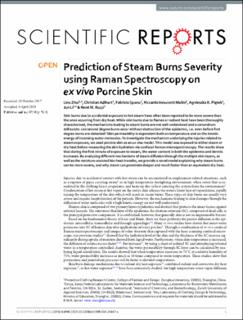Please use this identifier to cite or link to this item:
https://doi.org/10.21256/zhaw-3628Full metadata record
| DC Field | Value | Language |
|---|---|---|
| dc.contributor.author | Zhai, Lina | - |
| dc.contributor.author | Adlhart, Christian | - |
| dc.contributor.author | Spano, Fabrizio | - |
| dc.contributor.author | Innocenti Malini, Riccardo | - |
| dc.contributor.author | Piątek, Agnieszka K. | - |
| dc.contributor.author | Li, Jun | - |
| dc.contributor.author | Rossi, René M. | - |
| dc.date.accessioned | 2018-05-03T14:29:18Z | - |
| dc.date.available | 2018-05-03T14:29:18Z | - |
| dc.date.issued | 2018 | - |
| dc.identifier.issn | 2045-2322 | de_CH |
| dc.identifier.uri | https://digitalcollection.zhaw.ch/handle/11475/5743 | - |
| dc.description.abstract | Skin burns due to accidental exposure to hot steam have often been reported to be more severe than the ones occurring from dry heat. While skin burns due to flames or radiant heat have been thoroughly characterized, the mechanisms leading to steam burns are not well understood and a conundrum still exists: can second degree burns occur without destruction of the epidermis, i.e. even before first degree burns are detected? Skin permeability is dependent both on temperature and on the kinetic energy of incoming water molecules. To investigate the mechanism underlying the injuries related to steam exposure, we used porcine skin as an ex vivo model. This model was exposed to either steam or dry heat before measuring the skin hydration via confocal Raman microspectroscopy. The results show that during the first minute of exposure to steam, the water content in both the epidermis and dermis increases. By analyzing different mechanisms of steam diffusion through the multiple skin layers, as well as the moisture-assisted bio-heat transfer, we provide a novel model explaining why steam burns can be more severe, and why steam can penetrate deeper and much faster than an equivalent dry heat. | de_CH |
| dc.language.iso | en | de_CH |
| dc.publisher | Nature Publishing Group | de_CH |
| dc.relation.ispartof | Scientific Reports | de_CH |
| dc.rights | https://creativecommons.org/licenses/by/4.0/ | de_CH |
| dc.subject.ddc | 540: Chemie | de_CH |
| dc.subject.ddc | 610: Medizin und Gesundheit | de_CH |
| dc.title | Prediction of steam burns severity using raman spectroscopy on ex vivo porcine skin | de_CH |
| dc.type | Beitrag in wissenschaftlicher Zeitschrift | de_CH |
| dcterms.type | Text | de_CH |
| zhaw.departement | Life Sciences und Facility Management | de_CH |
| zhaw.organisationalunit | Institut für Chemie und Biotechnologie (ICBT) | de_CH |
| dc.identifier.doi | 10.21256/zhaw-3628 | - |
| dc.identifier.doi | 10.1038/s41598-018-24647-x | de_CH |
| zhaw.funding.eu | No | de_CH |
| zhaw.issue | 6946 | de_CH |
| zhaw.originated.zhaw | Yes | de_CH |
| zhaw.publication.status | publishedVersion | de_CH |
| zhaw.volume | 8 | de_CH |
| zhaw.publication.review | Peer review (Publikation) | de_CH |
| zhaw.webfeed | Funktionsmaterialien und Nanotechnologie | de_CH |
| zhaw.webfeed | Sensors and Measuring Systems | de_CH |
| Appears in collections: | Publikationen Life Sciences und Facility Management | |
Files in This Item:
| File | Description | Size | Format | |
|---|---|---|---|---|
| 2018_Zhai_Scientific Reports Prediction of Steam Burns Severity using Raman Spectroscopy on ex vivo Porcine Skin.pdf | 2.48 MB | Adobe PDF |  View/Open |
Show simple item record
Zhai, L., Adlhart, C., Spano, F., Innocenti Malini, R., Piątek, A. K., Li, J., & Rossi, R. M. (2018). Prediction of steam burns severity using raman spectroscopy on ex vivo porcine skin. Scientific Reports, 8(6946). https://doi.org/10.21256/zhaw-3628
Zhai, L. et al. (2018) ‘Prediction of steam burns severity using raman spectroscopy on ex vivo porcine skin’, Scientific Reports, 8(6946). Available at: https://doi.org/10.21256/zhaw-3628.
L. Zhai et al., “Prediction of steam burns severity using raman spectroscopy on ex vivo porcine skin,” Scientific Reports, vol. 8, no. 6946, 2018, doi: 10.21256/zhaw-3628.
ZHAI, Lina, Christian ADLHART, Fabrizio SPANO, Riccardo INNOCENTI MALINI, Agnieszka K. PIĄTEK, Jun LI und René M. ROSSI, 2018. Prediction of steam burns severity using raman spectroscopy on ex vivo porcine skin. Scientific Reports. 2018. Bd. 8, Nr. 6946. DOI 10.21256/zhaw-3628
Zhai, Lina, Christian Adlhart, Fabrizio Spano, Riccardo Innocenti Malini, Agnieszka K. Piątek, Jun Li, and René M. Rossi. 2018. “Prediction of Steam Burns Severity Using Raman Spectroscopy on Ex Vivo Porcine Skin.” Scientific Reports 8 (6946). https://doi.org/10.21256/zhaw-3628.
Zhai, Lina, et al. “Prediction of Steam Burns Severity Using Raman Spectroscopy on Ex Vivo Porcine Skin.” Scientific Reports, vol. 8, no. 6946, 2018, https://doi.org/10.21256/zhaw-3628.
Items in DSpace are protected by copyright, with all rights reserved, unless otherwise indicated.